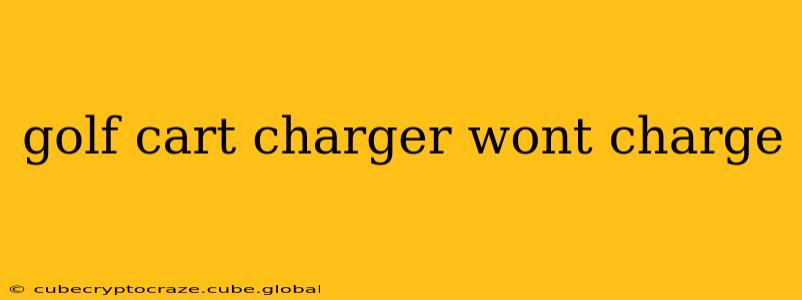Is your golf cart charger refusing to cooperate? A dead battery can quickly derail your golfing fun, so let's troubleshoot why your golf cart charger won't charge and get you back on the green. This comprehensive guide will cover common issues, solutions, and preventative measures to keep your golf cart battery healthy and your charging system reliable.
Why Isn't My Golf Cart Charger Charging?
This is the million-dollar question, isn't it? Several factors can prevent your golf cart charger from working correctly. Let's break down the most common culprits:
1. Power Supply Issues: Is the Outlet Working?
This may seem obvious, but the first thing to check is whether the outlet is functioning correctly. Plug another device into the same outlet to verify power. A faulty outlet, blown fuse, or tripped circuit breaker can completely prevent the charger from working. Check your home's breaker box or fuse panel for tripped breakers or blown fuses.
2. Charger Problems: Is the Charger Faulty?
Your golf cart charger itself might be the problem. Look for any visible damage to the cord, plug, or the charger unit itself. A damaged cord, loose connection, or internal component failure can prevent charging. Try a different outlet to rule out power supply issues before concluding the charger is at fault.
3. Battery Issues: Is the Battery Dead or Damaged?
A deeply discharged or damaged battery can sometimes prevent the charger from working effectively. A faulty battery cell can create a high internal resistance, causing the charger to shut down or fail to register the battery's presence. Check the voltage of your golf cart battery using a multimeter. If it’s significantly below the rated voltage, it might be the issue.
4. Connection Problems: Secure Connections are Key
Ensure all connections are clean and secure. This includes the connections between the charger, the battery cables, and the battery terminals themselves. Corrosion on the battery terminals is a common culprit. Clean them thoroughly with a wire brush and baking soda solution, ensuring a solid metal-to-metal connection.
5. Charger Settings and Compatibility: Right Charger, Right Battery?
Make sure you're using the correct charger for your golf cart battery type and voltage. Using an incompatible charger can damage both the charger and the battery. The charger's voltage and amperage should match the battery's specifications. Check the charger's manual and your battery's specifications to verify compatibility.
Golf Cart Charger Troubleshooting Steps
- Visual Inspection: Carefully examine the charger, cord, and connections for any signs of damage or loose connections.
- Check the Power Source: Ensure the outlet is working by testing it with another device.
- Clean Battery Terminals: Thoroughly clean the battery terminals and connections with a wire brush and baking soda solution.
- Test the Battery Voltage: Use a multimeter to measure the battery's voltage. A low voltage indicates a deeply discharged or potentially faulty battery.
- Inspect the Charger: Look for any indicators on the charger itself that might indicate a problem (e.g., error codes, flashing lights). Consult your charger's manual for troubleshooting tips.
- Try a Different Outlet: Rule out outlet issues by trying a different, known-good outlet.
- Try a Different Charger (if possible): If you have access to another compatible charger, try it to determine if the problem lies with the charger or the battery.
Preventative Maintenance for Golf Cart Chargers and Batteries
Regular maintenance significantly reduces the chances of encountering charging problems. Here's what you can do:
- Regularly Clean Battery Terminals: Clean them every few months, or more frequently in humid conditions.
- Check Water Levels (for Flooded Batteries): If you have flooded lead-acid batteries, regularly check and maintain the water levels.
- Store the Battery Properly: When not in use for extended periods, store the battery in a cool, dry place.
- Use the Correct Charger: Always use the charger designed for your specific battery type and voltage.
By following these troubleshooting steps and preventative maintenance practices, you can minimize the chances of your golf cart charger failing and ensure you're always ready for your next round. If you've tried these steps and are still experiencing issues, it's advisable to consult a professional golf cart technician.
